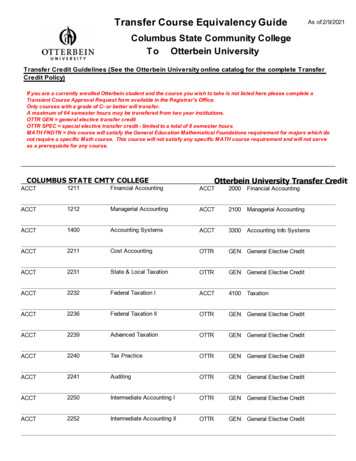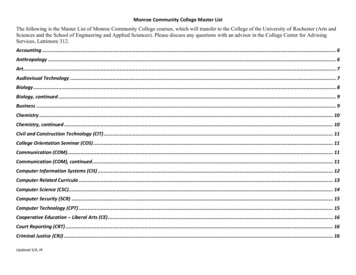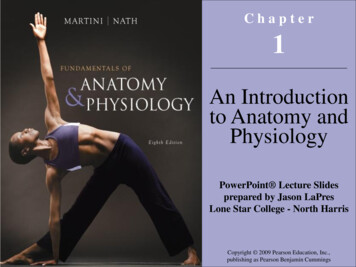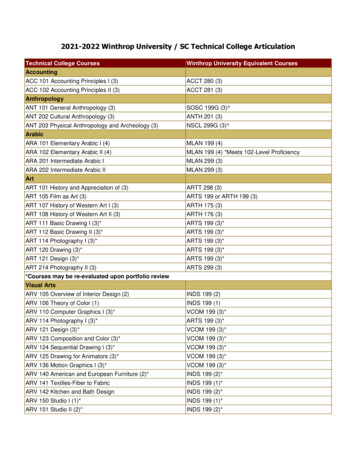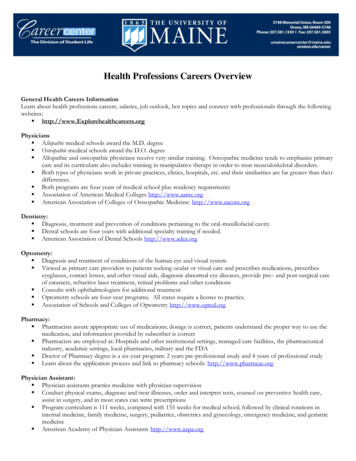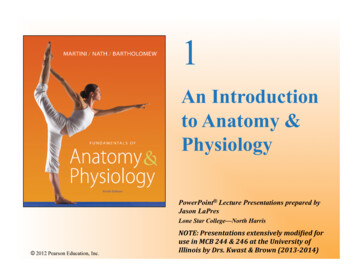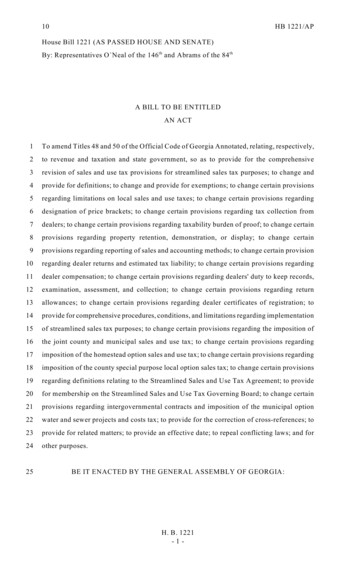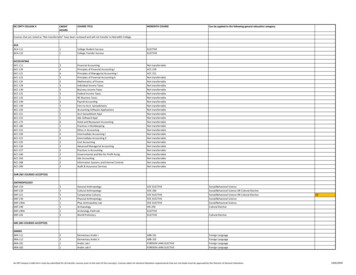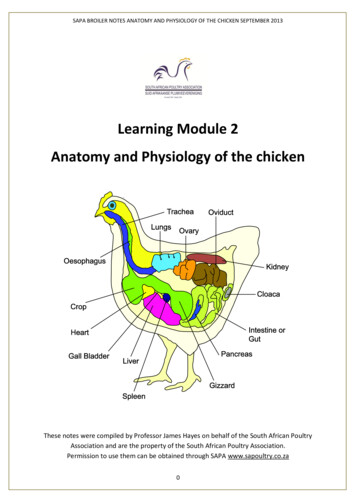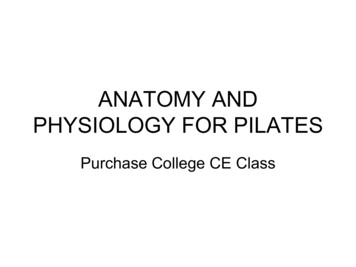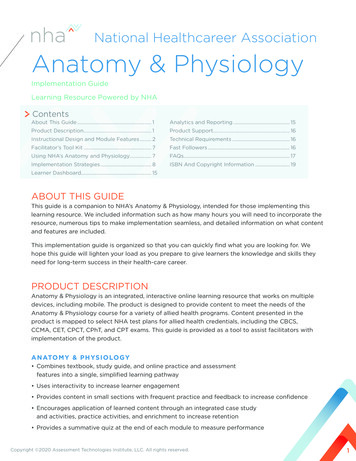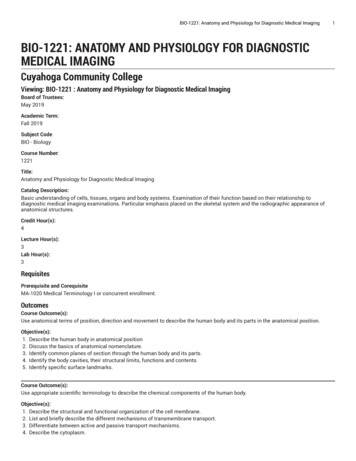
Transcription
BIO-1221: Anatomy and Physiology for Diagnostic Medical ImagingBIO-1221: ANATOMY AND PHYSIOLOGY FOR DIAGNOSTICMEDICAL IMAGINGCuyahoga Community CollegeViewing: BIO-1221 : Anatomy and Physiology for Diagnostic Medical ImagingBoard of Trustees:May 2019Academic Term:Fall 2019Subject CodeBIO - BiologyCourse Number:1221Title:Anatomy and Physiology for Diagnostic Medical ImagingCatalog Description:Basic understanding of cells, tissues, organs and body systems. Examination of their function based on their relationship todiagnostic medical imaging examinations. Particular emphasis placed on the skeletal system and the radiographic appearance ofanatomical structures.Credit Hour(s):4Lecture Hour(s):3Lab Hour(s):3RequisitesPrerequisite and CorequisiteMA-1020 Medical Terminology I or concurrent enrollment.OutcomesCourse Outcome(s):Use anatomical terms of position, direction and movement to describe the human body and its parts in the anatomical position.Objective(s):1. Describe the human body in anatomical position2. Discuss the basics of anatomical nomenclature.3. Identify common planes of section through the human body and its parts.4. Identify the body cavities, their structural limits, functions and contents.5. Identify specific surface landmarks.Course Outcome(s):Use appropriate scientific terminology to describe the chemical components of the human body.Objective(s):1. Describe the structural and functional organization of the cell membrane.2. List and briefly describe the different mechanisms of transmembrane transport.3. Differentiate between active and passive transport mechanisms.4. Describe the cytoplasm.1
25.6.7.8.BIO-1221: Anatomy and Physiology for Diagnostic Medical ImagingIdentify the major cellular organelles and briefly describe their functions in the cell.Briefly explain the process of gene expression including RNA and protein synthesis.Describe nuclear and cellular reproduction in somatic and gamete-producing cells.Briefly explain the consequences of abnormal nuclear and cellular reproduction in both somatic and gamete-producing cells.Course Outcome(s):Explain the essentials of human metabolism.Objective(s):1. Define anabolism and catabolism.2. Briefly explain the function of enzymes and their role in metabolism.3. Briefly describe the metabolism of carbohydrates, lipids and proteins.4. Explain homeostatic regulation and the roles of negative and positive feedback in maintaining the body.Course Outcome(s):Describe the structural and functional organization of the human body from the tissue through organ system levels.Objective(s):1. Identify and describe the four primary tissue types, the functional characteristics of each and give examples of their locationwithin the human body.2. Identify the organ systems, their constituent organs and their main functions in the human body.3. Understand the role of radiographic contrast media in the visualization of body tissues and organs.Course Outcome(s):Using appropriate anatomical terms for direction and orientation, identify and describe the components of the human skeleton, theirindividual features and their relationships to one another and other anatomical structures.Objective(s):1. Summarize the functions of the skeletal system.2. Describe the structural organization of osseous tissue.3. Describe the process of bone development and growth.4. State the classifications and markings of bones.5. Identify and locate all of the bones of the human skeleton including all processes, projections, depressions and openings.6. Be able to distinguish lefts from rights for selected disarticulated bones.7. Distinguish between the axial and appendicular divisions of the skeleton and identify the bones of each division and specific bonylandmarks.8. Differentiate between primary and secondary curves of the spine.9. Identify anatomy on radiographic images of all of the bones in human skeleton including all processes, projections, depressionsand openings.10. List and define the structural and functional joint classifications.11. Label different types of articulations.12. Compare the types, locations and movements permitted by the different types of articulations.13. Apply the appropriate structural and functional classifications to specific joints in the body.14. Describe common movements at joints in reference to anatomical planes.Course Outcome(s):Describe the structural and functional organization of the muscular system.Objective(s):1. State the function of each of the three types of muscle tissue.2. Name and locate the major muscles of the body.Course Outcome(s):Demonstrate basic knowledge of the central and peripheral nervous systems.
BIO-1221: Anatomy and Physiology for Diagnostic Medical Imaging3Objective(s):1. Differentiate between the structure and function of the different types of nerve cells.2. Label the parts of a neuron.3. State the functions of a neuron.4. List the different types of neuroglia and know their function.5. State the structure of the brain and the relationship of its component parts.6. Describe brain functions.7. List the meninges and describe the function of each.8. Outline how cerebrospinal fluid forms, circulates and functions.9. Identify interventricular foramen, cerebral aqueduct and the ventricles of the brain.10. Describe the structure and function of the spinal cord.11. Determine the distribution and function of the cranial and spinal nerves.12. List 12 pair of cranial nerves including the function of each.13. Distinguish between sympathetic nervous system and parasympathetic nervous system.14. Summarize the structure and function of components that comprise the autonomic nervous system.Course Outcome(s):Apply knowledge of the sensory system to understand the human body.Objective(s):1. Describe the structures and functions of the components that comprise the human eye and ear.2. List the component body parts involved in the senses of smell and taste.3. List the somatic senses.Course Outcome(s):Apply knowledge of the endocrine system to understand the human body.Objective(s):1. Define endocrine.2. Describe the characteristics and functions of the components that comprise the endocrine system.3. Distinguish between an endocrine and an exocrine gland.4. Know the homeostatic control of endocrine system.Course Outcome(s):Apply knowledge of the digestive system to understand the human body.Objective(s):1. Label the four quadrants and nine regions of the abdomen including organs contained in each.2. Describe the hard and soft palates.3. Describe the structure and function of the tongue.4. Identify the structure, function and locations of the salivary glands.5. Describe the composition and characteristics of the primary organs of the digestive system.6. Describe the function(s) of each primary organ of the digestive system.7. Differentiate between the layers of tissue that comprise the esophagus, stomach, small intestine, large intestine and rectum.8. Differentiate between peritoneum, omentum and mesentery9. List and label the accessory organs of the digestive system and describe their function.10. Identify the secretions and function of each accessory organ of the digestive system.11. List in order the steps of digestion and explain the purpose of digestion.12. List the digestive processes that occur in the body.13. Locate any abdominal organ with the aid of palpable landmarks.14. Identify specific anatomy on radiographic images to include the following esophagus, stomach, small intestine, large intestine andrectum.Course Outcome(s):Apply knowledge of the cardiovascular system to understand the human body.
4BIO-1221: Anatomy and Physiology for Diagnostic Medical ImagingObjective(s):1. Describe the composition and characteristics of blood.2. List the types of blood cells and state their functions.3. Differentiate between blood plasma and serum.4. Outline the clotting mechanism.5. List the blood types.6. Explain the term Rh factor.7. Explain the antigen/antibody relationship and its use in blood typing.8. Label the structures of the human heart.9. Trace the flow of blood from the superior and inferior vena cava through the heart to the aorta.10. Describe the flow of blood through the body and identify the main vessels.11. Label and identify major arteries and veins and their branches according to portion of the body which they supply.12. Describe the structure and function of arteries, veins and capillaries.13. Differentiate between arterial blood in systemic circulation and arterial blood in pulmonary circulation.14. Differentiate systemic, portal and pulmonary circulation.15. State the significance of systolic and diastolic pressures16. Correlate electrocardiogram (ECG) tracings to a normal cardiac rhythm.Course Outcome(s):Apply knowledge of lymphatic system to understand the human body.Objective(s):1. List and identify the lymphatic vessels, lymphatic organs and lymphatic tissue components of lymphatic system.2. Describe the formation and characteristics of lymph.3. State the function of lymphatic system.4. Outline the major pathways of lymphatic circulation.5. Differentiate between nonspecific defenses and specific immunity.6. Explain antibody production and function.7. List the different types and functions of T- and B-cells and explain their functions.8. Differentiate between passive and active immunity.Course Outcome(s):Apply knowledge of respiratory system to understand the human body.Objective(s):1. Name the divisions of the thorax and their contents.2. Label the components of the respiratory system.3. Describe the physiology and regulation of respiration.4. Identify specific anatomy on radiographic images to include the mediastinum, trachea, heart, lungs and diaphragm.Course Outcome(s):Apply knowledge of urinary system to understand the human body.Objective(s):1. Label the parts of the kidneys, ureters, bladder and urethra.2. Describe the function of each organ of the urinary system.3. Describe the composition and function of urine.4. Explain micturition.5. Identify specific anatomy on radiographic images to include kidneys, ureters and bladder.Course Outcome(s):Apply knowledge of reproductive system to understand the human body.
BIO-1221: Anatomy and Physiology for Diagnostic Medical ImagingObjective(s):1. Label the anatomy of the internal and external male and female reproductive organs.2. Analyze the function of each of the male and female reproductive organs.3. Trace the pathway of a sperm from its origin as it transits to the exterior.4. Explain reproductive physiology as it relates to the ovarian, cycle, menstrual cycle, aging and menopause.Course Outcome(s):Demonstrate knowledge of sectional anatomy in relation to the human body.Objective(s):1. Identify the major anatomical structures found within the head and neck.2. Identify the major anatomical structures located in the thorax.3. Identify the major anatomical structures located within the abdomen.4. Identify specific anatomy on radiographic images.Methods of Evaluation:1. Quizzes2. Written examinations3. Practical examinations including Radiographic Image EvaluationCourse Content Outline:1. Anatomical Nomenclaturea. Directional referencesi. Anterior/posteriorii. Ventral/dorsaliii. Medial/lateraliv. Superior/inferiorv. Proximal/distalvi. Cephalad/caudadb. Body planesi. Median/midsagittalii. Sagittaliii. Coronaliv. Transversev. Longitudinalc. Body cavities – structural limits, function, contentsi. Cranialii. Thoraciciii. Abdominal/pelvic2. Chemical Compositiona. Atomsb. Chemical bondsc. Inorganic compoundsi. Acidsii. Basesiii. Saltsiv. Waterd. Organic compoundsi. Carbohydratesii. Lipidsiii. Proteinsiv. Nucleotides1. DNA2. RNA3. Cell Structure and Genetic Control5
6BIO-1221: Anatomy and Physiology for Diagnostic Medical Imaginga. Cell membranei. Chemistryii. Structureiii. Physiologyiv. Transport processes1. Diffusion2. Osmosis3. Filtration4. Active transport and physiological pumps5. Phagocytosis and pinocytosisb. Cytoplasmc. Organellesi. Nucleusii. Ribosomesiii. Endoplasmic reticulumiv. Golgi complexv. Mitochondriavi. Lysosomesvii. Peroxisomesviii. Cytoskeletonix. Centrosome and centriolesx. Flagella and ciliad. Gene actioni. Protein synthesisii. Nucleic acid (RNA/DNA) synthesisiii. Transcriptioniv. Translatione. Cell reproductioni. Mitosisii. Meiosisf. Aberration and abnormal cell division4. Metabolisma. Anabolismb. Catabolismc. Enzymes and metabolismd. Carbohydrate metabolisme. Lipid metabolismf. Protein metabolismg. Regulation and homeostasis5. Tissuesa. Types of tissuei. Epithelialii. Connectiveiii. Muscleiv. Nerveb. Tissue repairc. Role of radiographic contrast media in the visualization of anatomical structures6. Skeletal Systema. Osseous tissuei. Structural organization1. Medullary cavity/marrow2. Compact bone3. Cancellous bone4. Periosteum5. Cartilageii. Development and growth1. Physis2. Diaphysis
BIO-1221: Anatomy and Physiology for Diagnostic Medical Imaging7.8.9.10.3. Epiphyseal line4. Metaphysisiii. Classification and markingsiv. Longv. Shortvi. Flatvii. Irregularviii. Processes and bony projectionsix. Depressions and openingsb. Divisionsi. Axial1. Skull2. Hyoid bone3. Vertebral column4. Thoraxii. Appendicular1. Pectoral girdle2. Upper extremities3. Pelvic girdle4. Lower extremitiesiii. Sesamoidsiv. Functionsc. Radiographic appearance of bones to include all processes, projections, depressions and openings.d. Articulationsi. Types1. Synarthroses, fibrosis2. Amphiarthroses, cartilaginous3. Diarthroses, synovialii. MovementMuscular Systema. Types and characteristicsi. Smoothii. Cardiaciii. Skeletalb. FunctionsNervous Systema. Neural tissue – structure and functioni. Neuronsii. Neurogliab. Central nervous system – structure and functioni. Brain and cranial nervesii. Spinal cordc. Peripheral nervous system – structure and functioni. Sympathetic nervesii. Parasympathetic nervesSensory Systema. General sensesi. Nociperceptionii. Chemoreceptioniii. Thermoreceptioniv. Mechanoreceptionb. Special senses – structure, functioni. Visionii. Hearing and equilibriumiii. Olfactioniv. Gustationv. TactileEndocrine System7
8BIO-1221: Anatomy and Physiology for Diagnostic Medical Imaginga. Primary organs - structure, function and locationb. Homeostatic controlc. Endocrine tissue and related hormonesi. Pituitary (hypophysis) glandii. Pineal glandiii. Thyroid glandiv. Parathyroid glandv. Adrenal (suprarenal) glandsvi. Heart and kidneysvii. Digestive systemviii. Pancreasix. Testesx. Ovariesxi. Thymusxii. Placenta11. Digestive Systema. Primary organs – structure, function and locationi. Oral cavityii. Esophagusiii. Stomachiv. Small intestinev. Large intestinevi. Rectumb. Accessory organs – structure, function and locationi. Salivary glandsii. Pancreasiii. Liveriv. Gallbladderc. Digestive processesi. Ingestionii. Peristalsisiii. Segmentationiv. Digestionv. Absorptionvi. Defecationd. Radiographic appearance of primary digestive structures12. Cardiovascular Systema. Bloodi. Compositionii. Clotting systemiii. Hemopoiesisiv. Functionb. Heart and vesselsi. Anatomyii. Functionc. Electrocardiogram (ECG) tracings correlated to normal cardiac rhythm13. Lymphatic System and Immunitya. Lymphatic systemi. Lymph vesselsii. Lymphatic organs1. Thymus2. Lymph nodes3. Spleeniii. Lymphatic tissue1. Tonsils2. Peyer’s patchesb. Immune system
BIO-1221: Anatomy and Physiology for Diagnostic Medical Imaging14.15.16.17.i. Nonspecific defenses1. Physical barriers2. Leukocytes3. Immunological surveillanceii. B-cell response1. Production2. Types of immunoglobulins3. Function4. Regulation of B-cell responseiii. T-cell response1. Production2. Types3. Function4. Regulation of T-cell responseiv. Passive and active immunityRespiratory Systema. Components, structure and functioni. Nose and sinus cavitiesii. Pharynxiii. Larynxiv. Tracheav. Bronchivi. Lungsvii. Thoraxb. Physiologyi. Pulmonary ventilationii. Alveolar gas exchangeiii. Transport of blood gasesiv. Tissue gas exchangev. Control and regulation of respirationc. Radiographic appearance of primary structures in the thoraxUrinary Systema. Components, structure and functioni. Kidneysii. Uretersiii. Bladderiv. Urethrab. Urinei. Physical characteristicsii. Chemical compositionc. Micturitiond. Radiographic appearance of primary urinary structuresReproductive Systema. Male – structure, function and locationi. External organsii. Internal organsb. Female – structure, function and locationi. External organsii. Internal organsiii. Mammary glandsc. Reproductive physiologyi. Ovarian cycleii. Menstrual cycleiii. Aging and menopauseIntroduction to Sectional Anatomya. Structures and locationsb. Head/neck9
10BIO-1221: Anatomy and Physiology for Diagnostic Medical Imagingi. Brainii. Craniumiii. Major vesselsc. Thoraxi. Mediastinumii. Lungiii. Heartiv. Airwayv. Major vesselsd. Abdomeni. Liverii. Biliaryiii. Spleeniv. Pancreasv. Kidneys and uretersvi. Peritoneumvii. Retroperitoneumviii. Gastrointestinal (GI) tractix. Major vesselse. Radiographic appearance of primary structures in the head/neck, thorax and abdomenResourcesGreathouse, Joanne S. Delmar's Radiographic Positioning Procedure. New York: Delmar Publishers, 1998.Shier, David, et al. Holes Essentials of Human Anatomy and Physiology. 13th ed. New York: WCB/McGraw-Hill, 2017.Shier, David, Jackie Butler & Ricki Lewis. Terry R. Martin. Laboratory Manual for Holes' Essentials of A & P. McGraw Hill, 2017.Wicke, Lothar. Atlas of Radiologic Anatomy. 6th ed. Baltimore: Williams Williams, 1998.Long, B.W., Hall Rollins, J., Smith, B.J. Merrill's Atlas of Radiographic Positions and Radiologic Procedures. 6th ed. St. Louis: ElsevierMosby, 2018.Top of pageKey: 912
126. List imaging modalities that use cross-sectional imaging for diagnostic purposes. 127. Describe the standard image presentation (viewing orientation) used in cross sectional medical imaging. 128. Identify major anatomical structures in a cross-sectional format. Methods of Evaluation: 1. Quizzes 2. Written examinations 3.
